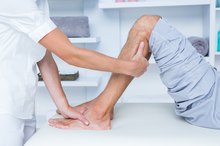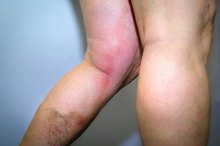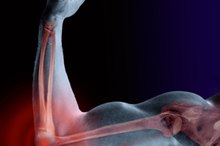Causes of Right Calf Swelling
Calf swelling occurs for a variety of reasons.
When it develops in only one leg, the cause is likely a localized problem rather than a systemic disorder.
Poor circulation, a blood clot, and a bacterial skin infection are among the most common causes of one-sided calf swelling.
However, because many conditions can lead to this symptom, see your doctor for an accurate diagnosis and appropriate treatment. Your doctor will consider accompanying symptoms, the appearance of the skin of your leg, how quickly the swelling developed, and your age and sex to narrow the list of possible causes.
Deep Venous Thrombosis
Sudden, one-sided calf swelling raises a concern for deep venous thrombosis (DVT). With this condition, a blood clot forms in a deep vein of the body. The calf is a common site for DVT and possible symptoms include: -- swelling of the calf and ankle -- achy or heavy sensation -- diffuse redness -- tenderness over site of the clot -- engorged superficial veins -- low fever
Risk factors for DVT include smoking, cancer, and surgery, injury or a prolonged illness that limits mobility. DVT can lead to a serious complication called pulmonary embolism in which part of the clot breaks off and lodges in the lungs, impairing blood flow and oxygen uptake.
- Sudden, one-sided calf swelling raises a concern for deep venous thrombosis (DVT).
- DVT can lead to a serious complication called pulmonary embolism in which part of the clot breaks off and lodges in the lungs, impairing blood flow and oxygen uptake.
Venous Insufficiency
DVT Symptoms in the Legs
Learn More
Blood that flows through the legs must return to the heart against the force of gravity when in an upright position. Muscle contractions of the legs help push the blood up the legs, and valves within the veins prevent backward flow.
Damage to the veins of the legs cause pooling of blood in the lower legs with fluid leakage and swelling. This condition is called venous insufficiency. A previous leg DVT or injury can predispose to venous insufficiency with calf and ankle swelling.
Venous insufficiency develops gradually, most commonly occurs in older adults, and often causes few symptoms in the early stages. However, the condition typically worsens over time and leads to an array of possible signs and symptoms in the affected leg, including: -- heaviness, achiness, cramps or pain, especially with standing or walking -- reddish brown discoloration of the skin -- burning sensation or itchiness -- nonhealing ulcers
- Blood that flows through the legs must return to the heart against the force of gravity when in an upright position.
- Damage to the veins of the legs cause pooling of blood in the lower legs with fluid leakage and swelling.
Cellulitis
Cellulitis refers to a bacterial infection of the skin and underlying soft tissue that causes swelling, redness and pain.
Fever commonly accompanies the infection and the affected area skin is characteristically warm. The redness typically expands -- often over a period of hours -- as the infection spreads outward. Cellulitis commonly affects the lower leg, especially among people with poor circulation, venous stasis, diabetes or a chronic skin condition. However, the condition can occur in occur in anyone and might develop after even a relatively minor injury, such as a scratch, cut or insect bite. Cellulitis requires antibiotic treatment to prevent the infection from spreading deeper into the body or the bloodstream.
- Cellulitis refers to a bacterial infection of the skin and underlying soft tissue that causes swelling, redness and pain.
- Cellulitis commonly affects the lower leg, especially among people with poor circulation, venous stasis, diabetes or a chronic skin condition.
Musculoskeletal Injury
What Are The Symptoms of Blood Clots in The Leg?
Learn More
Injuries affecting the lower leg potentially cause one-sided calf swelling.
A high-energy blow to the calf can obviously cause bruising and swelling.
Other injuries might also cause swelling, such as a calf muscle strain, or tear. This type of injury often occurs during athletic activities that require abrupt pushing off from the foot, such as during racket sports or soccer.
Pain occurs suddenly at the time of the injury and a knot at the top of the calf might appear.
Rarely, a lower leg injury might trigger the development of reflex sympathetic dystrophy syndrome (RSDS).
RSDS causes severe, increasing pain related to an overactive nervous system response. The skin over the painful area might be red, swollen and exquisitely sensitive.
- Injuries affecting the lower leg potentially cause one-sided calf swelling.
- A high-energy blow to the calf can obviously cause bruising and swelling.
Popliteal Cyst
A popliteal cyst can also lead to one-sided calf swelling. With this condition, a fluid-filled sac forms at the back of the knee. The cyst appears as a knob beneath the skin, and most commonly occurs in people with knee damage due to arthritis or a significant injury. Rupture of a popliteal cyst, also known as a Baker cyst, can cause sudden calf swelling in the affected leg.
The symptoms of a ruptured popliteal cyst can mimic those of a DVT.
Furthermore, people with a popliteal cyst are at increased risk for DVT. A physical exam and ultrasound testing can differentiate these conditions.
- A popliteal cyst can also lead to one-sided calf swelling.
- The symptoms of a ruptured popliteal cyst can mimic those of a DVT.
Lymphedema
The lymphatic circulation works alongside the blood circulatory system.
Removing excess fluid from the body tissues is a major function of the lymphatic circulation.
Damage to or obstruction of the lymphatic circulation affecting the lower leg -- often due to surgery, tumors, injuries or radiation therapy -- can cause swelling called lymphedema. The condition may affect the calf, leading to swelling and other possible symptoms, including: -- a sensation of heaviness -- burning, tingling or numbness -- tightness of the skin
Lymphedema swelling typically increases gradually without treatment, and can become disfiguring or limit mobility. However, the condition can usually be controlled with early and ongoing treatment.
- The lymphatic circulation works alongside the blood circulatory system.
- Removing excess fluid from the body tissues is a major function of the lymphatic circulation.
Warnings and Precautions
See your doctor as soon as possible if you notice gradual swelling of one calf, even if you have no other symptoms. Seek medical care right away if you develop sudden, one-sided calf swelling as this could signal a blood clot or an infection. Go to the nearest emergency room if you experience calf swelling along with any warning signs or symptoms, including: -- fever or chills -- rapidly spreading redness -- ulcers, blisters or black spots on the skin of the calf -- severe or worsening pain -- shortness of breath or difficult breathing -- dizziness, lightheadedness or fainting
Reviewed and revised by: Tina M. St. John, M.D.
Related Articles
References
- American Family Physician: Edema: Diagnosis and Management
- Journal of the American Board of Family Medicine: Approach to Leg Edema of Unclear Etiology
- Merck Manual Professional Version: Deep Venous Thrombosis
- Merck Manual Professional Version: Chronic Venous Insufficiency and Postphlebitic Syndrome
- Clinical Infectious Disease; David Schlossberg
- Current Reviews in Musculoskeletal Medicine: Gastrocnemius vs. Soleus Strain: How to Differentiate and Deal With Calf Muscle Injuries
- Patient.info: Professional Reference: Baker's Cyst
- National Organization for Rare Disorders: Reflex Sympathetic Dystrophy Syndrome
- Rainbow CR, Fields KB. Calf injuries not involving the Achilles tendon. Fricker P, ed. UpToDate. Updated Feb 7, 2019.
- Chikazawa K, Netsu S, Akashi K, Suzuki Y, Konno R, Motomatsu S. Delayed diagnosis of single compartment muscle contusion after radical hysterectomy in the lithotomy position: A case report. Int J Surg Case Rep. 2016;26:199-201. doi:10.1016/j.ijscr.2016.07.057
- Fields KB, Rigby MD. Muscular Calf Injuries in Runners. Curr Sports Med Rep. 2016;15(5):320-4. doi:10.1249/JSR.0000000000000292
- Freedman BR, Gordon JA, Soslowsky LJ. The Achilles tendon: fundamental properties and mechanisms governing healing. Muscles Ligaments Tendons J. 2014;4(2):245-55.
- Alessandrino F, Balconi G. Complications of muscle injuries. J Ultrasound. 2013;16(4):215-22. doi:10.1007/s40477-013-0010-4
- Picerno V, Filippou G, Bertoldi I, et al. Prevalence of Baker's cyst in patients with knee pain: an ultrasonographic study. Reumatismo. 2014;65(6):264-70. doi:10.4081/reumatismo.2013.715
- Baima J, Krivickas L. Evaluation and treatment of peroneal neuropathy. Curr Rev Musculoskelet Med. 2008;1(2):147-53. doi:10.1007/s12178-008-9023-6
- Petsche TS, Selesnick FH. Popliteus tendinitis: tips for diagnosis and management. Phys Sportsmed. 2002;30(8):27-31.doi:10.3810/psm.2002.08.401
- Stager A, Clement D. Popliteal artery entrapment syndrome. Sports Med. 1999;28(1):61-70. doi:+10.2165/00007256-199928010-00006
- Mcdermott MM. Lower extremity manifestations of peripheral artery disease: the pathophysiologic and functional implications of leg ischemia. Circ Res. 2015;116(9):1540-50. doi:10.1161/CIRCRESAHA.114.303517
- Crum-cianflone NF. Bacterial, fungal, parasitic, and viral myositis. Clin Microbiol Rev. 2008;21(3):473-94. doi:10.1128/CMR.00001-08
- Somford MP, Hoornenborg D, Wiegerinck JI, Nieuwe weme RA. Are You Positive That the Simmonds-Thompson Test Is Negative? A Historical and Biographical Review. J Foot Ankle Surg. 2016;55(3):682-3. doi:10.1053/j.jfas.2016.01.021
- Pulivarthi S, Gurram MK. Effectiveness of d-dimer as a screening test for venous thromboembolism: an update. N Am J Med Sci. 2014;6(10):491-9. doi:10.4103/1947-2714.143278
- Bryan dixon J. Gastrocnemius vs. soleus strain: how to differentiate and deal with calf muscle injuries. Curr Rev Musculoskelet Med. 2009;2(2):74-7. doi:10.1007/s12178-009-9045-8
- Mackman N. Triggers, targets and treatments for thrombosis. Nature. 2008;451(7181):914-8. doi:10.1038/nature06797
- Muir RL. Peripheral arterial disease: Pathophysiology, risk factors, diagnosis, treatment, and prevention. J Vasc Nurs. 2009;27(2):26-30. doi:10.1016/j.jvn.2009.03.001
- American Academy of Orthopedic Surgeons. Muscle Contusion (Bruise). Updated 2014.
- American Physical Therapy Association. Physical Therapist's Guide to Calf Strain. Updated Oct. 17, 2019.
- Childress MA, Beutler A. Management of Chronic Tendon Injuries. Am Fam Physician. 2013 Apr 1;87(7):486-90.
- Grabowski G, Whiteside WK, Kanwisher M. Venous Thrombosis in Athletes. J Am Acad Orthop Surg. 2013 Feb;21(2):108-17.
- Rainbow CR, Fields KB. Calf injuries not involving the Achilles tendon. Fricker P, ed. Updated Feb 7, 2019.
Writer Bio
Kathleen Blanchard is a registered nurse, with more than 10 years of experience in cardiovascular health, emergency room and ICU. She writes professionally for Emaxhealth.com. and AskMen.com. Blanchard is currently employed as a senior case manager and has held certification as a critical care registered nurse (CCRN), advanced trauma life support (ATLS), and advanced cardiac life support (ACLS).









